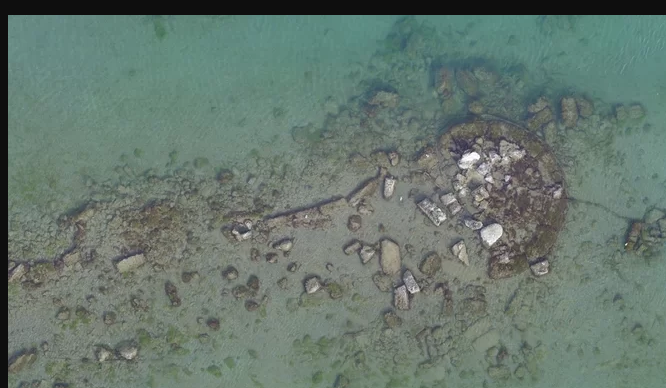
The ancient harbor was identified as being located in the small and well-protected Bay of Ambelaki, in the eastern part of the Greek island, during an archaeological search by a team of 20 experts from two Greek universities — the Ephorate of Underwater Antiquities and the Hellenic Institute of Marine Archaeology — according the Greek Ministry of Culture and Sports.
"This is the first systematic underwater reconnaissance to be initiated by Greek institutions in a severely polluted marine environment, yet in a crucial area of historical importance," the ministry said. [10 Epic Battles That Changed History]
The survey identified remains of port structures, fortifications and other buildings dating from the Classical period (from the fifth to fourth centuries B.C.) and Hellenistic period, on all three sides — north, west and south — of the bay. (The beginning of the Hellenistic period is usually marked by the death of Alexander the Great in 323 B.C.)
Such features are only visible at low tides at certain times of the year.
The fortified northwestern part of the bay is the prime evidence for the identification of that special 'closed area' as the main military zone of the harbor of Salamis, certainly an Athenian territory in Classical times," Yannos Lolos, professor of archaeology at the University of Ioannina and president of the Hellenic Institute of Marine Archaeology, told Live Science.
Indeed, the area is defined on the south by an impressive long wall, or jetty, which runs for about 200 feet (160 meters) and ends in a strong round tower similar to those found in other fortified harbors. An enormous stone structure called a mole extends for 160 feet (50 m) along the east side of this "main military zone."
Other submerged remains on the south side of the bay include breakwaters, a 130-foot-long (40 m) mole and a 100-foot-long (30 m) wall with an attached square, tower-like structure.
"This evidence, supplemented by the information from ancient historical and literary sources, leaves no doubt about the role of the bay as the main assembly and launching point of the Greek fleet in close proximity to the theater of the sea battle in the straits," Lolos said.
According to Greek historian Herodotus, 378 Greek triremes (so called because they were propelled by three tiers of oarsmen) rowed, fought and defeated the much larger invading Persian fleet led by King Xerxes.
The epic battle was won after the Athenian politician and general Themistocles lured the Persian fleet into the narrow straits that separate the Greek mainland from Salamis.
"It is difficult to predict what would have happened if the Greeks had lost at Salamis, but it is clear that a Persian victory would have had immense consequences, not only for Greece, but also for the rest of Europe," University of Copenhagen archaeologist Bjørn Lovén told Live Science.
The Greek victory, Lovén noted, led directly to the Golden Age of Athens — a century that saw explosive developments in democratic government, philosophy, medicine, the natural sciences, architecture, visual arts, drama and literature.
"Had the Persians won, I truly doubt that we would have seen the effects that these amazing cultural and social developments have had on us today," Lovén said.
Last year, Lovén shed more light on that decisive battle when he found underwater remains of a naval base in Mounichia Harbor in the city of Piraeus. Along with massive fortifications, his team found several ship sheds that likely housed the triremes that were deployed in Salamis.
"The new discovery is clearly very important. I find it fascinating that the harbor site where the allied Greek fleet was stationed before the battle has been defined," Lovén said.
The search in the waters of the historical Bay of Ambelaki will continue until 2018, Lolos said.
Although it's unlikely that a trireme — the holy grail of underwater archaeology — will be found, Lolos is confident that the newly built underwater archaeological map of the area will lead to new discoveries.
"I am fairly hopeful that future underwater discoveries in the wider area of Ambelaki will comprise finds, of all kinds, which may prove to have an association with crucial events of Athenian history of the fifth century B.C.," Lolos said.



R.C.